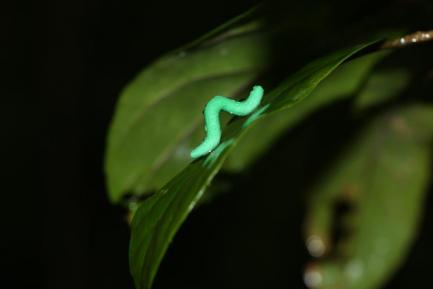Predators Are Real Lowlifes
By deploying green clay caterpillars across six continents, researchers unmasked an important global pattern. Their study will be published in Science May 19. Their discovery that predation is most intense near sea level in the tropics—in places like their study sites at the Smithsonian Tropical Research Institute (STRI) in Panama—provides a foundation for understanding biological processes from crop protection and carbon storage to the effects of climate change on biodiversity.
Insects drove the trend, not mammals or birds. “As someone who has studied insect biodiversity in the tropics for most of my life, I wasn’t surprised that insects were responsible for most of the predation observed,” said Yves Basset, leader of the ForestGEO Arthropod Initiative at STRI.
The team put out almost 3,000 model caterpillars for four to 18 days at 31 different sites from Australia to Greenland at different altitudes, from zero to 2,100 meters above sea level. Based on characteristic marks left by predators in the clay, they could tell whether the models were attacked by birds, mammals or insects.
Tropical sites were the most dangerous. In Greenland, the daily chances of a caterpillar model being attacked by a predator were only 13 percent of the odds at the equator. And for every 100 meters of increase in altitude, the chance of being attacked fell by almost 6.6 percent. At the highest forested site, the daily odds of a predator attack was only 24 percent of the odds of attack at sea level.
“Most previous studies that didn’t support the conclusion that predation is more intense in the tropics were pieced together from evidence gathered in different ways by different groups of people,” Basset said. “My colleagues and I were part of a team of people from around the world who all used the same method at different sites, including a few of the ForestGEO sites. We deployed many replicates of fake caterpillars, modeled after a geometrid moth, and analyzed our results together.”
“This seems like a very simple experiment but the results are relevant to the way we understand some of the important processes in nature, like the innovation of defenses and how temperature changes may affect biodiversity,” Basset said. “The results further emphasize the power of citizen science for simple, yet significant experiments.”
“Caterpillars eat plants, therefore causing crop damage and forcing plants to create new chemicals in their leaves to defend themselves,” Basset said. “Caterpillars also defend themselves from predators. Our finding that predation pressure is stronger in the tropics also suggests that insects in the tropics have to be more innovative in order to defend themselves.”
The authors of this study represented 35 research centers and universities, including STRI; the Swedish University of Agricultural Sciences; the University of Helsinki, Finland; the Institute of Entomology, Czech Academy of Sciences; the University of South Bohemia, Czech Republic; the New Guinea Binatang Research Center; the University of California-Irvine; Eidgenossische Technische Hochshule, Zurich; the University of Texas-Arlington; the University of New England, Australia; the University of Alberta, Edmonton; the University of Iceland; the University of Sao Paolo; the University of Hong Kong; the Natural History Museum of Denmark, Copenhagen; Instituto de Ecología, Xalapa, Mexico; Escuela Politécnica Nacional, Ecuador; the University of Ostrava, Czech Republic; Zoological Society of London, the University of Oxford; the University of Turku, Finland; Chinese Academy of Sciences; the University of Aberdeen; Makerere University, Uganda; Swarthmore College, U.S.; the State Institution of Education, Zditovo, Belarus; Aarhus University, Demark; the University of Tartu, Estonia; the University of Bergen, Norway; the University of Beyruth, Germany; and the University of Lancaster, UK.
The Smithsonian Tropical Research Institute, headquartered in Panama City, Panama, is a part of the Smithsonian Institution. The Institute furthers the understanding of tropical nature and its importance to human welfare, trains students to conduct research in the tropics and promotes conservation by increasing public awareness of the beauty and importance of tropical ecosystems. STRI website: http://www.stri.si.edu.
# # #
Roslin. T., Hardwick, B., Novotny, V. et al. 2017. Higher predation risk for insect prey at low latitudes and elevations. Science.
SI-296-2017
Beth King
202-633-4700 x 28216


